May Monarch robes 1881 to the present
The dresses and robes made for the May Monarchs over the years reflect changes in contemporary fashion and are a unique feature of the Whitelands May Monarch festival. These changes are visible when former May Monarchs return for a new investiture. Each dress can be regarded as a work of art and the College possesses a valuable collection of robes bequeathed by former May Monarchs, as well as the unique crosses with which each was invested.
The dresses were originally made to fit any student since voting did not take place until May Day morning. Consequently the robes tended to be flowing and loose-fitting garments with areas of intricate embroidery. A later development was to collect measurements from every girl eligible for election, to hold the election prior to May Day and then to make a dress specifically for the winner. Later still the result of the election was announced in advance thereby enabling the newly elected monarch to choose the style of their own robes.
Until the 1980s most robes were designed and handmade by College members. Thereafter monarchs tended to choose off-the-hanger occasion dresses or waistcoats and suits, while monarchs have also celebrated their cultural backgrounds.
This selection of images and descriptions exemplifies the changing trends through time
(All images copyright of Whitelands College)
| Year | Name | Information | Associated Image |
|---|---|---|---|
| 1881 | Ellen | ‘The student elected was in mourning for her father and was dressed completely in sombre black. Quick thinking by the Head Governess led to her placing her own large white silk evening shawl over the black dress and adding garlands of flowers’ [M Cole, Whitelands College May Queen Festival, 1981, p22] After this it was decided to provide subsequent queens with a special dress. ‘Photos quite safe, but I’m rather frightened of my queen. She looks to me between 35 and 38, and rather as if she would bring back the inquisition and trial by the rack. Photographs are horrid things.’ [Ruskin in a letter to Faunthorpe, 22nd May 1881] |
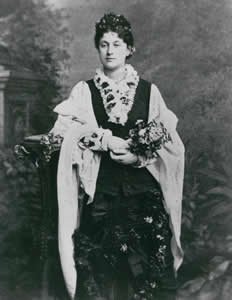 |
| 1890 | Thyra | The first May Queen to wear this dress, designed by Kate Greenaway and made at the Royal College of Needlework, was Queen Margaret in 1887. It was also worn by Queens Thyra, Jessie and Annie I. ‘… a gown of apple green silk, with cream cashmere tunic, embroidered with pansies, and a crown of pear-blossom’ [From College Memoranda No 9, 1888, p58] |
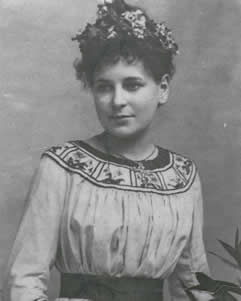 |
| 1903 | Muriel | In the early days many of the dresses were made of exotic silks and ornate brocades sought from Liberty’s Regent Street emporium. Queen Muriel wore the first robe made by Miss Birch: ‘She wore a crown of apple-blossoms, a loose cream silk robe, with a green girdle overlaid with delicate applique; the long cream Liberty silk train was daintily embroidered with a quaint conventional design in the colours of apple-blossom with its attendant leaves.’ [The School Guardian May 9, 1903, p.400] |
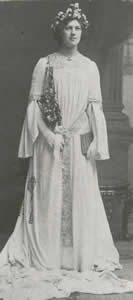 |
| 1907 | Elsie II | ‘…Queen Elsie arrayed in soft clinging robes of pale green silk held by two tiny children..’ [The School Guardian May 4, 1907, p.400] ‘A charming flowering gown embroidered in careful detail. The detachable collar is a cunning idea as a finish to the neckline – well disguising the practical attachment of the train’s detail…’ There were similar dresses and trains for the next 12 years. |
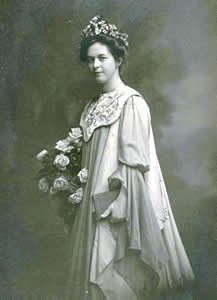 |
| 1911 | Elsie | The dress is decorated with what are believed to be commercial motifs. Two different designs are adapted to build up a rich flower border from round the neck, down the centre front to the hem. A wreath with ribbon motif and a small border of leaves and flowers which complement the main motifs of the dress, decorate the sleeves. The sleeve drapes of pink chiffon and cream silk are finished with matching fabric ball tassels to give weight to the floating panels. The pink silk train worked in double sided satin stitch, so that the work is the same on both sides, shows stylised simple stemmed flowers reflecting the art nouveau design of the period. The scale, placing and variation of the selected motifs form a rich repeat pattern. [Archive exhibition info] |
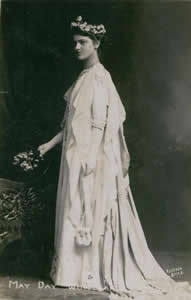 |
| 1919 | Janet | ‘Year by year visitors ask the question “And why does the Queen’s robe always suit her exactly?” We can only answer that the fates are kind to May Queens. This year the robe demanded a wearer of Spring-light fairness, and behold a fair-headed Queen was there to grace it. An effort had been made to recapture some of the girlish simplicity of the dress designed at Ruskin’s request by Kate Greenaway…. 'This year’s robe, designed by Miss Sharp, was made of a beautiful hand woven material, and round the edge of its short tunic was a broad band of Spring flowers, embroidered by Miss Smith in their natural colours – crocus, cowslip, scilla, aconite – a garland for Proserpina…..’ |
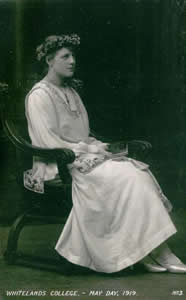 |
| 1921 | Celia | ‘… We all wore white dresses and the chosen Queen was taken from the Hall to the vice principal’s room to be robed in the dress made ready for her. As the May Queen’s name was not known until May Day morning the dress had to be fairly adaptable to a large or small person. I remember a row of different sizes of white silk shoes for me to try on. 'The Queen then processed back to the Hall where she was crowned with a floral crown (mine was cowslips), presented with her cross by a visiting V.I.P., her flowers and Ruskin book. The couplet embroidered round my tunic is “SEARCH THE FLOWER PEOPLE THROUGH – THERE IS NO FLOWER FOUND LIKE YOU”. The dress was designed and made by Miss F.M. Smith, vice principal of the College. [Memories of May Day in 1921 by Queen Celia] |
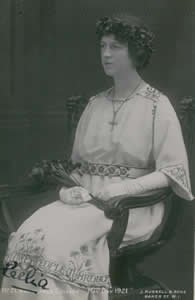 |
| 1934 | Dorothy III | ‘We were a large family to greet our new sister Dorothy, “divinely tall and fair” and very winsome in her lovely gown of pale green and gold brocade, with cowslip crown, and sceptre of gold arums.’ [Sisterhood of Queen Ellen notes, Annual 1934] |
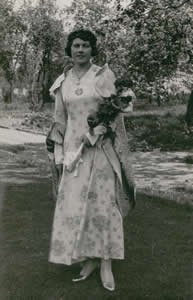 |
| 1937 | Betty | ‘In those days the queen was chosen only two days beforehand. The dress was made by the needlework department with plenty of spare material for last minute alterations’ [letter from Margot Sharp, one of Queen Betty’s attendants] |
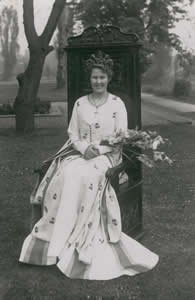 |
| 1941 | Audrey | During the wartime period of the 1940’s, austerity dictated the choice of fabric, and demanded more inventiveness. Gowns were created from muslins, mosquito and curtain netting, parachute silk and blackout material. There were similar simple designs until 1947. The inspiration for Queen Audrey’s dress was the Maypole. Students were invited to give ribbons which were used to join the panels of the skirt. It was designed by Miss Murton, a Whitelands College Lecturer, who designed many May Day dresses. This was the first of the wartime economy dresses – hence the use of curtain voile netting. The names of the students, who gave the ribbons, were written inside the hem – now almost illegible. |
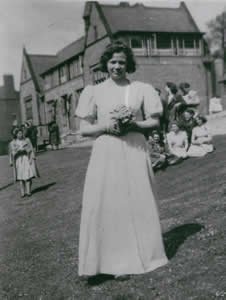 |
| 1951 | Janet II | ‘The College crest formed the basis of the brocaded design’ [Annual 1951] This was a ‘yellow net dress’ with a ‘heavy pinkish corded silk jacket’ and ‘yellow mittens’ [Queen’s own description of her dress] |
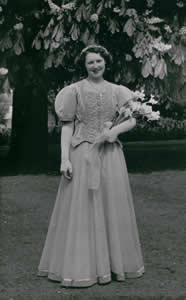 |
| 1953 | Vera | ‘There was a gasp of pleasure as she came in wearing the most beautiful pale yellow and gold silk dress made in the old Elizabethan style; it was certainly worthy of Coronation year and Vera with her auburn hair and lovely smile looked beautiful.’ [Annual 1953] |
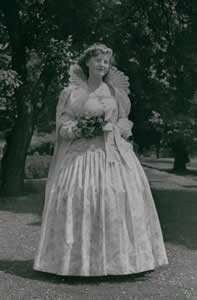 |
| 1956 | Janet III | The 1950’s were an interesting time with many of the first man-made, synthetic fabrics being used to make dresses. ‘Her dress has been inspired by the beauty of the cherry trees in College grounds – delicate petal folds of pale green net with the hanging jewels of the dew scattered amongst them.. [Annual 1956] |
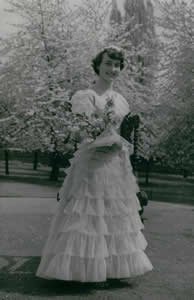 |
| 1964 | Mary III | ‘Pink – the shade of pink cherry blossom.. partly inspired by the revival of Camelot in the West End.. …designed by a 3rd year needlework student adapted from a Vogue pattern….. '1964 was the last year (I think) of matching the original flowers of each Queen. Because of [my] matching circlet I was the first ‘retiring’ Queen not to have a forget-me-nots crown.’ [Queen Mary’s notes, 1981] |
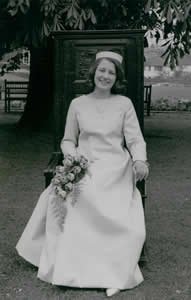 |
| 1969 | Hyacinth | ‘…..the following arrangements were agreed for 1969….. the May Queen would be elected early in the year and announced shortly after voting at a college meeting. Her dress would, as now, be made by students taking Art and Craft as a main course, and would be designed for her and fitted on her…..’ [Letter from the Principal 17th July 1968] ‘Our new Sister Queen Hyacinth was robed strikingly in apricot flame, decorated with gold braid round the sleeves of her simple-styled dress. Coming from the West Indies she has lived in London for ten years and was Head Girl of her Secondary School. We found it very moving when the Bishop of Ely invested her with her cross during the Chapel Service.’ [Annual 1969] |
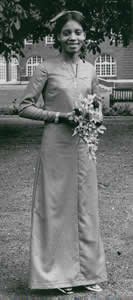 |
| 1971 | Pamela | ‘Turquoise Indian silk, empire line, buttoning at front, hood’ [Queen Pamela’s notes on her dress] ‘It was proposed to hand my cross onto the next May Queen therefore my name was never engraved on it – only ‘Whitelands’. However it never did get passed on- one was made for the next one and so on’ |
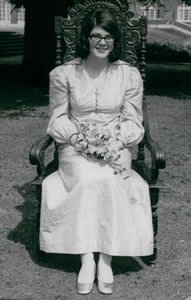 |
| 1973 | Frances | The 1970’s saw a Liberty revival, with floral printed Tana Lawn cotton being used. ‘Cream, with blue flowers, trimmed with cream lace, polyester cotton, Victorian high neck, with pin-tuck front. ‘I was the last May Queen to have the heavy linked chain and cross’ [Queen Fran’s notes on her dress] |
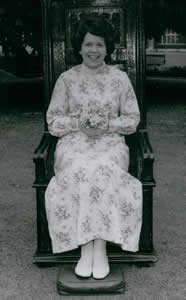 |
| 1977 | Theresa | ‘The May Queen is no longer just a one day social wonder chosen by a small group of junior students…. She is, in effect, an officer of the College and of the Students’ Union with a responsibility for all students…’ [College Bulletin Feb 1978] ‘I thought [Theresa’s dress] quite the most beautiful of recent years… When I saw Theresa in something that was clearly a ‘robe’ clearly having the style of an occasion, reflecting both the joys of summer meadows and the dignified seriousness of an event, I was moved and delighted.’ [Letter from Principal – Roy Knight – 9 May 1977] |
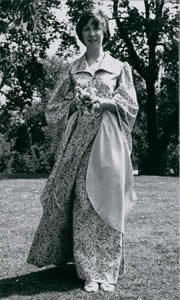 |
| 1979 | Sara | ‘Almost oriental. A long dress with slits up the side, wide waist band tie sash. Trousers to match. ‘My outfit was different – more modern style – trousers for the first time, and slits up the side of the dress. 'One attendant was a man. The 3 girl attendants all wore the same material but different patterns, all short styles and not full length.’ [Queen Sara’s notes] |
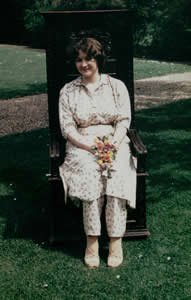 |
| 1981 | Heather | ‘Although the Kate Greenaway style was taken as the inspiration for the hundredth May Queen’s dress the style was adapted to make a 1981 influenced dress. ‘ [Heather Forbes: Dress] Heather had volunteered to make the May Queen dress months earlier, and as a result of being herself elected, designed and made her own dress. |
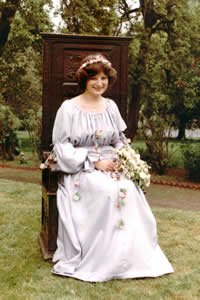 |
| 1986 | Gary | Once the College became mixed the election was no longer confined to women. However it took until 1986 for the first male to be elected. King Gary wore a specially designed waistcoat. David Peacock wrote to Roy Knight re the waistcoat, 22 May 1986: ‘It may have looked plain but it took hours to create. I suspect some people would have liked to see something more flamboyant, but Gary was determined that his special day should be marked by a sober sophistication’ |
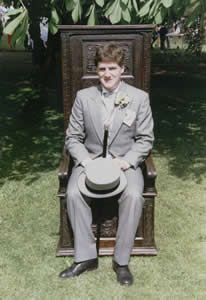 |
| 1992 | Annabel | ‘Annabel chose to wear a handsome gown of peach-coloured satin with a front bodice panel machine embroidered in metallic and silk threads with her initial and trailing ivy leaves and with a hidden secret in its daringly red lining. This dress was the first of three to be sponsored by Liberty’s, the Regent Street store, 1992 being the year of their exhibition of artefacts associated with Ruskin.’ [Guild Newsletter 31, 2000] There was a budget of £300 for the dress which featured Angela Dewar’s artwork for the embroidery. [memo from DP to Queen 3 Mar 1992] |
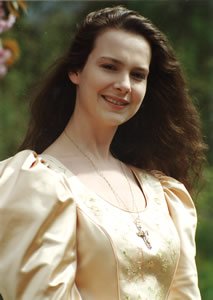 |
| 1997 | Kojo | 'King Kojo’s parents came to the UK from Ghana and it is from there that he has drawn his inspiration for his May Monarch costume and ceremonial cross…He is our first black May King, but not our first black May Monarch – that honour lies with Queen Hyacinth’ [press release 1 May 1997] |
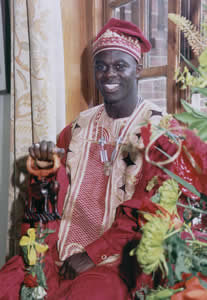 |
| 2000 | Shez (Sherezer) | The 2000 May Day celebrations held extra significance as they formed part of a programme of events marking the centenary of Ruskin’s death. ‘Sherezer wore a cream Indian style suit with gold embroidery round the collar’ [Newsletter] His family are from India and his grandfather was a priest in the Church of North India. |
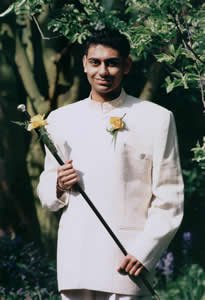 |
| 2013 | Sara | Queen Sara with former Monarchs. | 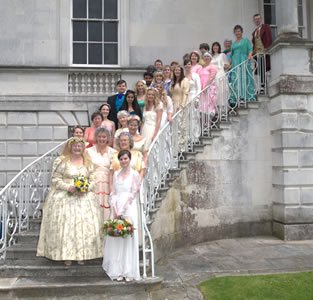 |
